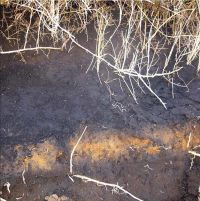C storage in Allophanic soils: possibilities and challenges
Reducing the emissions of greenhouse gases such as carbon dioxide into the atmosphere remains a huge challenge for the 21st century. Maintaining or increasing C storage in soil is of fundamental importance in dealing with this challenge.
Soil organic matter and its component C are stabilised in soil both with aluminium and through interactions with the smallest mineral particles, of which allophane, imogolite, ferrihydrite are the most reactive members. These reactive minerals, only nanometres in size, are abundant in New Zealand Allophanic Soils derived from pumice and volcanic ash. They have a strong propensity to adsorb humic substances, microbial biomass, and organic acids. Thus, Allophanic Soils usually have much higher C content than other soils in the same environment.
The ability of Allophanic Soils to stabilise organic matter may be utilised to maintain or even enhance soil C storage. To this end, facilitating the contact and mixing of organic matter (e.g., plant residue and root excreta) with the reactive minerals is important. This may be achieved by: (1) incorporating organic matter into subsoil layers where reactive mineral content is high; and (2) spreading the reactive mineral-rich subsoil on the surface of land. In either way, the reactive minerals can meet, capture, and stabilise the organic molecules from the decaying plant residue, root excreta, and microbial biomass. The first method has not been extensively practised in New Zealand where pastoral agriculture predominates. However, it will occur under cultivation, although ploughing to a depth of about 20 cm would not mix organic residues with reactive minerals that are abundant at deeper depths (e.g., > 40 cm). In contrast, the second method has been occurring naturally since time immemorial. For instance, the Chinese Loess Plateau contains a 7-million-year record of aeolian deposits among which lie many ancient topsoil layers of high C content. Similarly, continuous volcanic-ash deposition surrounding Mount Aso in southern Japan together with the release of reactive aluminium from the ash have resulted in large C accumulation in topsoil (Fig. 1).
It was recently estimated that a change of 0.2% in soil C across the 11 million ha of grazed pasture in New Zealand represents a C trading value of $5 billion. The significant economic implication of soil C change, the technological feasibility, and the agronomical and environmental effects of maintaining or increasing soil C content require investigation. These research topics are being addressed by the NZ Agricultural GHG Research Centre and SLMACC (Sustainable Land Management and Climate Change) projects initiated by MAF last year.
Guodong Yuan

Figure 1. C accumulation in a Japanese soil (black top layer is about 1 m, C = 16.8%) helped by volcanic ash deposition in the past 7000 years.

Figure 2. Allophanic soil near New Plymouth (C in the top 20 cm = 8.5%).
